Founded 1820 | ||
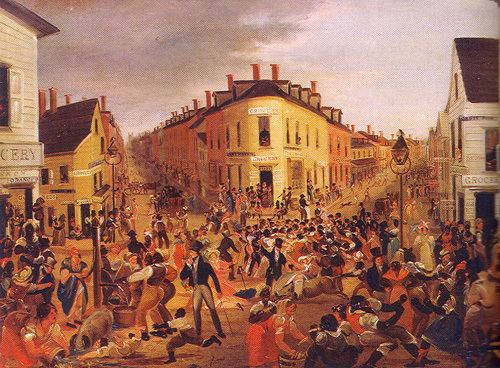 | ||
People places things five points manhattan
Five Points (or The Five Points) was a neighborhood in Lower Manhattan, New York City. The neighborhood was generally defined as being bound by Centre Street to the west, the Bowery to the east, Canal Street to the north, and Park Row to the south. The former Five Points is now split between the Civic Center to the west and south, and Chinatown to the east and north.
Contents
- People places things five points manhattan
- Name
- Collect Pond
- The Slum
- Infectious diseases
- Anti abolitionist riots of 1834
- Dead Rabbits Riot
- New York City draft riots
- Social reform and renewal
- Current use
- Maps
- Gangs of New York
- Other films
- Manga
- Literature
- Television
- Music
- Sport
- References
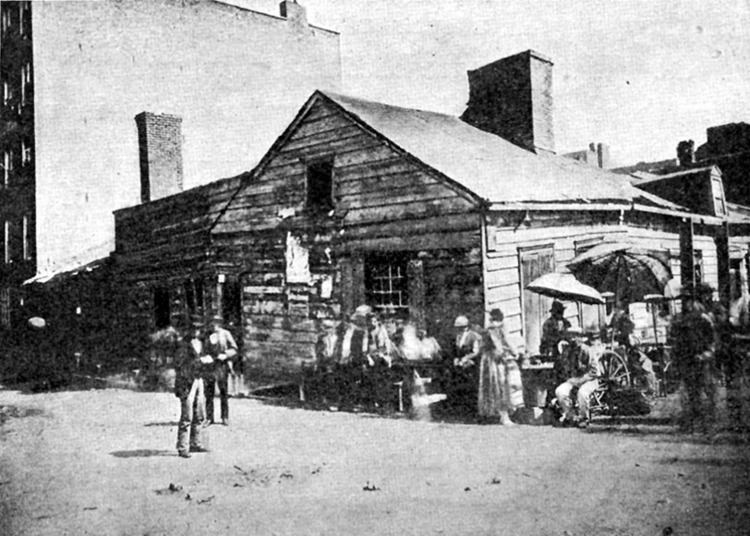
Five Points gained international notoriety as a disease-ridden, crime-infested slum that existed for well over 70 years.
Name
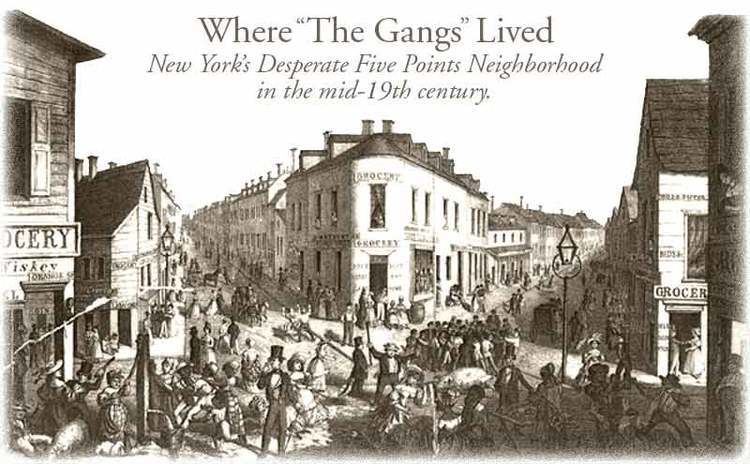
The name "Five Points" was derived from the five-pointed intersection created by Orange Street (now Baxter Street) and Cross Street (now Mosco Street); from this intersection Anthony Street (now Worth Street) began and ran in a northwest direction, dividing one of the four corners into two triangular-shaped blocks; thus the fifth "point." To the west of this "point" ran Little Water Street (which no longer exists) north to south, creating a triangular plot which would become known as "Paradise Square," after the buildings standing in the triangle were torn down in 1832.
Collect Pond
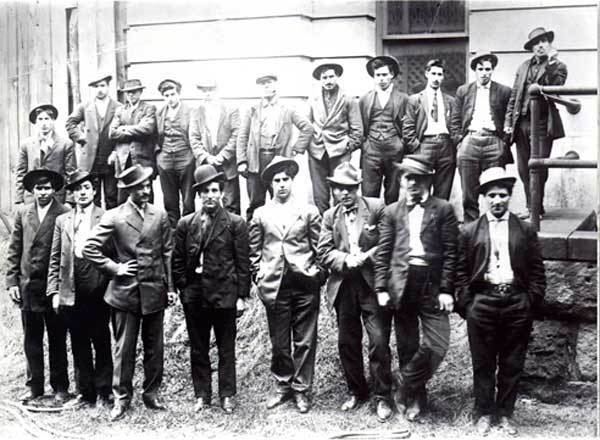
The topography of the area that would become Five Points was a major factor in the progression of the neighborhood from middle class homes built upon reclaimed land to a sprawling, disease-ridden slum within a relatively short period.
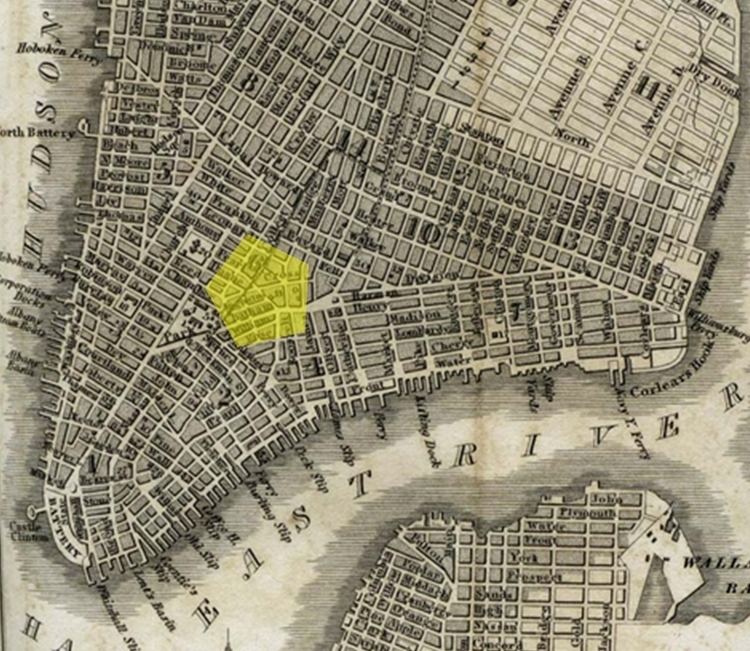
The Collect Pond (or Fresh Water Pond) was a body of spring-fed fresh water, occupying approximately 48 acres (194,000 m²) and as deep as 60 feet (18 metres). The pond was located in an inverted U-shaped valley with a linear portion in the north heading northwest to the Hudson River. The eastern and western sections of the valley were separated by a hill the Dutch called Kalk Hoek (Dutch for Chalk Corner), named for the numerous oyster-shell middens left by original inhabitants. The elevation rose in the south, with Pot Bakers Hill dominating the south southwestern shore.
The pond was located in the eastern section of the valley, with Kalck Hoek to the west and Bayard Mount – at 110 feet (34 metres), the tallest hill in Lower Manhattan – to the northeast. A stream flowed north out of the pond and then northwest through a salt marsh (which, after being drained, became "Lispenard Meadows") to the Hudson River, and another stream, known as the Old Wreck Brook or the Old Kil, flowed out from the southeast through Bestevaer Swamp (later Beekman's Swamp), called Bestevaer Kreupelbosch by the Dutch, to the East River. The southwestern shore of the pond was the site of a Native American settlement known as Werpoes. A small band of Canarsie, who were Munsee Peoples – the northernmost division of the Lenape – occupied the site until the Dutch settlement of New Amsterdam was established.
The pond was the main source of drinking water and freshwater fish for the City of New York.
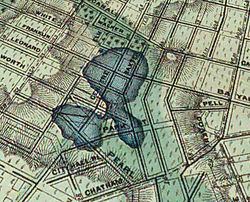
Beginning in the early 18th century, various commercial enterprises were built along the pond's shores, in order to use the water. These businesses included Coulthards Brewery, Nicholas Bayard's slaughterhouse on Mulberry Street (which was nicknamed "Slaughterhouse Street"), numerous tanneries on the southeastern shore, and the pottery works of German immigrants Johan Willem Crolius and Johan Remmey on Pot Bakers Hill, on the south-southwestern shore.
The contaminated wastewater from these businesses flowed back into the pond, creating a severe pollution problem and environmental health hazard. Pierre Charles L'Enfant proposed cleaning the pond and making it a centerpiece of a recreational park, around which the residential areas of the city could grow. However, his proposal was rejected, and it was decided to fill in the pond. This was done with fill partially obtained from leveling Bayards Mount and Kalck Hoek. The landfill was completed in 1811, and middle-class homes were soon built on the reclaimed land.
The landfill was poorly engineered. The buried vegetation began to release methane gas (a byproduct of decomposition), and the area, still in a natural depression, lacked adequate storm sewers. As a result, the ground gradually subsided. Houses shifted on their foundations, the unpaved streets were often buried in a foot of mud mixed with human and animal excrement, and mosquitos bred in the stagnant pools created by the poor drainage. Most middle and upper class inhabitants fled the area, leaving the neighborhood open to poor immigrants who began arriving in the early 1820s. This influx reached a height in the 1840s, with large numbers of Irish Catholics fleeing the Irish Potato Famine.
The Slum
At Five Points' "height", only certain areas of London's East End vied with it in the western world for sheer population density, disease, infant and child mortality, unemployment, prostitution, violent crime, and other classic ills of the urban destitute. However, it could be considered the original American melting pot, at first consisting primarily of newly emancipated blacks (gradual emancipation led to the end of slavery in New York on July 4, 1827) and Irish, who had a small minority presence in the area since the 1600s. The local politics of "the Old Sixth ward" (The Points' primary municipal voting district), while not free of corruption, set important precedents for the election of Catholics to key offices. Before that time, New York, and America at large, were governed by the Anglo-Protestant founders. Although there were many tensions between the Africans and the Irish, their cohabitation in Five Points was the first large-scale instance of volitional racial integration in American history. In the end, the Five Points African community moved to Manhattan's West Side and to the then-undeveloped north of the island.
Five Points is alleged to have sustained the highest murder rate of any slum in the world. According to an old New York urban legend, The Old Brewery, an overcrowded tenement on Cross Street housing 1,000 poor, is said to have had a murder a night for 15 years, until its demolition in 1852.
"Almack's" (also known as "Pete Williams's Place"), an African-owned dance hall located at 67 Orange Street in Mulberry Bend (today Baxter Street), just south of its intersection with Bayard Street, was home to a fusion of Irish reels and jigs with the African shuffle. This had happened in other parts of the United States in which different ethnic groups merged, this music and dance had spontaneously developed on the street from competition between African and Irish musicians and dancers, spilling into Almack's, where it gave rise in the short term to tap dance (see Master Juba) and in the long term to a music hall genre that was a major precursor to American jazz and rock and roll. This ground is now Columbus Park.
Infectious diseases
Infectious diseases, such as cholera, tuberculosis, typhus, and yellow fever, had plagued New York City since the Dutch colonial era. The poor sanitary conditions, overcrowded dwellings, and lack of even rudimentary health care made impoverished areas such as Five Points ideal for the development and transmission of these diseases. Several epidemics swept the City of New York in the 18th and 19th centuries, some of which originated in Five Points. In June 1832, an outbreak of cholera in Five Points spread rapidly throughout the crowded, unsanitary dwellings of the neighborhood before spreading to the rest of New York City. Cholera epidemics would break out again in 1849 and 1866. These epidemics were seen by some as resulting from the immorality of the residents of the slum:
"Every day's experience gives us assurance of the safety of the temperate and prudent, who are in circumstances of comfort.... The disease is now, more than before rioting in the haunts of infamy and pollution. A prostitute at 62 Mott Street, who was decking herself before the glass at 1 o'clock yesterday, was carried away in a hearse at half past three o'clock. The broken down constitutions of these miserable creatures, perish almost instantly on the attack.... But the business part of our population, in general, appear to be in perfect health and security."
Anti-abolitionist riots of 1834
The Anti-abolitionist riots of 1834, also known as the Farren Riots, occurred in New York City over a series of four nights, beginning July 7, 1834. Their deeper origins lay in the combination of nativism and abolitionism among Protestants, who had controlled the city since the American Revolution, and the fear and resentment of blacks among the growing numbers of Irish. In 1827, Great Britain repealed legislation controlling and restricting emigration from Ireland, and 20,000 Irish emigrated. By 1835, more than 30,000 Irish had arrived in New York annually. Among the casualties of the riots was St. Philip's Episcopal Church, a Black church at 122 Centre Street, which was sacked and looted by the mob.
Dead Rabbits Riot
The "Dead Rabbits" was the media's designation for a branch of the "Roach Guards", a violent Irish gang. The Dead Rabbits Riot began when one faction destroyed the headquarters of the Bowery Boys at 26 Bowery, on July 4, 1857. The Bowery Boys retaliated, which led to a large-scale riot which waged back and forth on Bayard Street, between Bowery and Mulberry Street. There would be further rioting on July 5. The Bowery Boys and Dead Rabbits fought again in front of 40 and 42 Bowery Street (original buildings still extant in May 2011), erecting barricades in the street. On July 6, the Bowery Boys fought the Kerryonians (Irishmen from County Kerry) at Anthony and Centre Street. Historian Tyler Anbinder says the "dead rabbits" name "so captured the imagination of New Yorkers that the press continued to use it despite the abundant evidence that no such club or gang existed." Anbinder notes that, "for more than a decade, 'Dead Rabbit' became the standard phrase by which city residents described any scandalously riotous individual or group."
Taking advantage of the disorganized state of the city's police force, brought about by the conflict between the Municipal and Metropolitan police, the fighting would spiral into widespread looting and damage of property by gangsters and other criminals from all parts of the city. It is estimated that between 800 and 1,000 gang members took part in the riots, along with several hundred others who used the disturbance to loot the Bowery area. It was the largest disturbance since the Astor Place Riot in 1849, and the biggest scene of gang violence, unsurpassed until the 1863 draft riots. Order was only restored by the New York State Militia, supported by detachments of city police, under Major-General Charles W. Sandford. Eight people were reported killed, and more than 100 people were seriously injured.
New York City draft riots
Five Points, a center of interracial life at the time, was notably spared during the New York City draft riots. The riots, which took place from July 13 to July 16, 1863 (known at the time as Draft Week), were a response by those who particularly resented that wealthier men, who could afford to pay a $300 (equivalent to $5,746 in 2015) commutation fee to hire a substitute, and the city’s free black population, who competed with many Irish immigrants for unskilled low-wage jobs.
Social reform and renewal
Various efforts by different charitable organizations and individuals, most Christian themed, attempted to ameliorate the suffering of the poor in Five Points. Padre Felix Varela, a Cuban-born priest, established a Roman Catholic parish—The Church of the Immigrants—later renamed the Church of the Transfiguration, in Five Points in 1827, to minister to the poor Irish Catholics. The parish relocated to the corner of Mott and Cross Street in 1853, when they purchased Zion Protestant Episcopal Church (c.1801) from the Episcopalian congregation.
The first call for clearing the slums of Five Points through wholesale demolition came in 1831 from merchants who maintained businesses in close proximity to the Five Points neighborhood. Slum clearance efforts (promoted in particular by Jacob Riis, author of How the Other Half Lives), succeeded in razing Mulberry Bend, one of the worst sections of the Five Points neighborhood, which was turned into a park designed by Calvert Vaux called Mulberry Bend Park, now called Columbus Park, that opened in 1897.
A major effort was made to clear the Old Brewery, described as "a vast dark cave, a black hole into which every urban nightmare and unspeakable fear could be projected." The Old Brewery had formerly been Coulthard's Brewery, the brewery that was on the outskirts of the city less than thirty years earlier. It now sat on Cross Street in growing Manhattan, just south of the Five Points intersection. The brewery became the "Old Brewery" when it was converted into a tenement in 1837. Its lower, high-ceilinged floor and the above two floors were converted into four floors of apartments. The rent was cheap and attracted many low-income tenants, many of them immigrants. The only census taken in 1850 reported 221 people living in 35 apartments, averaging 6.3 persons per apartment. There are conflicting accounts of just how many people were packed into the Brewery apartments, but by all accounts it was filled to overcapacity.
The destitution seen throughout the Five Points neighborhood was on display at the Old Brewery, causing the women of the Home Mission to take action. The Home Mission was a Methodist charity group determined to clean up Five Points. The Christian Advocate and Journal reported on the ongoing project and its origin in October 1853: "In a meeting held in Metropolitan Hall, in December 1851, such convincing proof was given of the public interest in this project, that the resolution was passed by the Executive Committee to purchase the Old Brewery. Other appeals were made to the public, and nobly met. That celebrated haunt was purchased, in a few months utterly demolished, and already a noble missionary building occupies its site."
The New Mission House replaced the Old Brewery, under the direction of the Five Points Mission. It provided housing, clothes, food and education as part of the charitable endeavor. The new building had 58 rooms available for living space, twenty-three more than the Old Brewery had offered.
Current use
The area formerly occupied by Five Points is today covered in part in the west and south by large city, state, and federal administration buildings and courthouses known collectively as Civic Center, Manhattan, plus Columbus Park, Collect Pond Park, Foley Square, and various facilities of the New York City Department of Corrections clustering around lower Centre Street. The corrections facilities are the most direct link to the neighborhood's past, as the infamous Tombs Prison, in which many criminals from Five Points were incarcerated and quite a few executed, stood near the site of the current "City Prison Manhattan" at 125 White Street. The northeastern and eastern portion of Five Points is now part of sprawling Chinatown. Many tenement buildings dating from the late 19th century still line the streets in this area.
The exact location of the former "Five Points" intersection itself is currently the intersection of Worth (formerly Anthony) and Baxter (formerly Orange) Streets. Mosco (formerly Cross) Street no longer extends to that intersection, having been cut off at Columbus Park. The section of Baxter Street south of Worth Street is no longer a street; it is now the location of the Daniel Patrick Moynihan United States Courthouse. Little Water Street also no longer exists, either.
Maps
The physical layout of the Five Points intersection changed throughout the 19th and early 20th centuries.
Gangs of New York
Gangs of New York (2002) is a historical film set in the mid-19th century, in the Five Points district of New York City. The film, directed by Martin Scorsese and written by Jay Cocks, Steven Zaillian, and Kenneth Lonergan, was inspired by Herbert Asbury's nonfiction book, The Gangs of New York (1928). It was made at Cinecittà, Rome, distributed by Miramax Films, and nominated for numerous awards, including the Academy Award for Best Picture.
The film begins in 1846 and quickly jumps to 1862. The two principal issues of the era in New York were Irish immigration to the city and the Federal government's execution of the ongoing Civil War.
The story follows gang leader William "the Butcher" Cutting (Daniel Day-Lewis), a character primarily based on William Poole, in his roles as crime boss and political kingmaker under the helm of "Boss" Tweed (Jim Broadbent). The film culminates in a violent confrontation between Cutting and his mob, on one side, and the protagonist Amsterdam Vallon (Leonardo DiCaprio) and his immigrant allies, on the other, which coincides with the New York City draft riots of 1863.
Other films
Manga
Literature
Television
Music
Sport
The soccer club the New York Cosmos' supporters group is called The Five Points.
